Author: Fairy,
Edit: TB,
This year marks the tenth year of the birth of Ethereum.
Over the past decade, it has supported the prosperity of DeFi and triggered a wave of NFT. Countless developers and idealists converge, collide and build on this chain, writing one encrypted narrative after another.
But in this tenth year, Ethereum has reached a crossroads of destiny. New public chains are emerging one after another, narrative dominance is frequently lost, and prices have lost momentum in the long adjustment.
Can Ethereum, which has been baptized by ten years of ups and downs, still usher in a huge "pump"?
Chipstendconcentrated,Ethereum is "changing the dealer"?
The statement about Ethereum's "change the dealer" has actually been circulating last year. Some people believe that the old OGs in the early stage who held ETH are gradually withdrawing, and the chips are being quietly taken over by institutions such as Wall Street. Is this transformation real or a story told to yourself?
According to on-chain analyst @Murphychen888, ETH's Hefendal Index (measures the concentration of chips) has continued to decline since 2016, indicating that the chips are spreading to retail investors. Until it bottomed out in March 2023, it suddenly rose since December 2024.Indicates that there is funds re-concentrated holdings。Whether it is actively increasing positions or passively replenishing positions, the whales' actions are pushing up concentration.
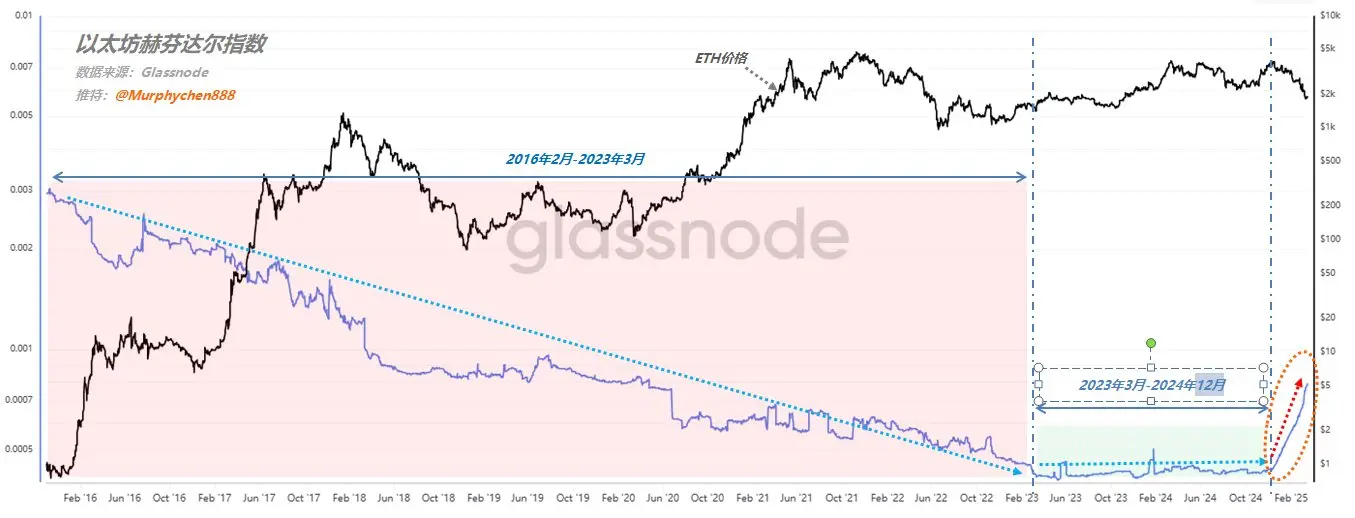
Ethereum Hefendal Index: That is, chip concentration
A high index means a small number of large holders are dominating the market, while a low index means a more even chip distribution
However, this is an extremely slow process, as some large companies are still continuing to ship, reducing the concentration trend. Although this increase in concentration will help improve the future price trend, the process is slow and may be a long and tormenting wait for market participants.
In addition, ETH's "belief buyer" RSI (relative strength index) has always reached 80 since the end of March, while loss sellers have cooled down rapidly after reaching peak in mid-April.This shows that despite the sharp pullback of prices, there are still firm buyers who continue to take over the market., it has not stopped since March 26th.

RSI is used to measure the market overbought or oversold
Range from 0 to 100. Usually RSI > 70 means overbought, RSI < 30 means oversold
It is still unclear whether Ethereum is really "changing the dealer", but the on-chain data shows a trend of re-concentration of chips. Perhaps behind this is the long-term layout of large funds and the persistence of faith buyers.
Ethereum's "heart-changing" proposal: The execution layer plans to welcome the largest upgrade
On April 20, Vitalik released a major proposal to replace the current Ethereum virtual machine (EVM) with open source instruction set architecture RISC-V as the long-term evolution direction of the execution layer of Ethereum Layer 1.
According to the design, existing EVM contracts will continue to run and be two-way compatible with the new architecture, and core abstractions such as account models, cross-contract calls, and storage will also be fully preserved. The original operation codes such as SLOAD, SSTORE, BALANCE, CALL, etc. will be mapped as system calls of RISC-V. The new architecture supports writing contracts in languages such as Rust, and is also adapted to existing languages such as Solidity and Vyper, so the developer experience is basically unaffected.
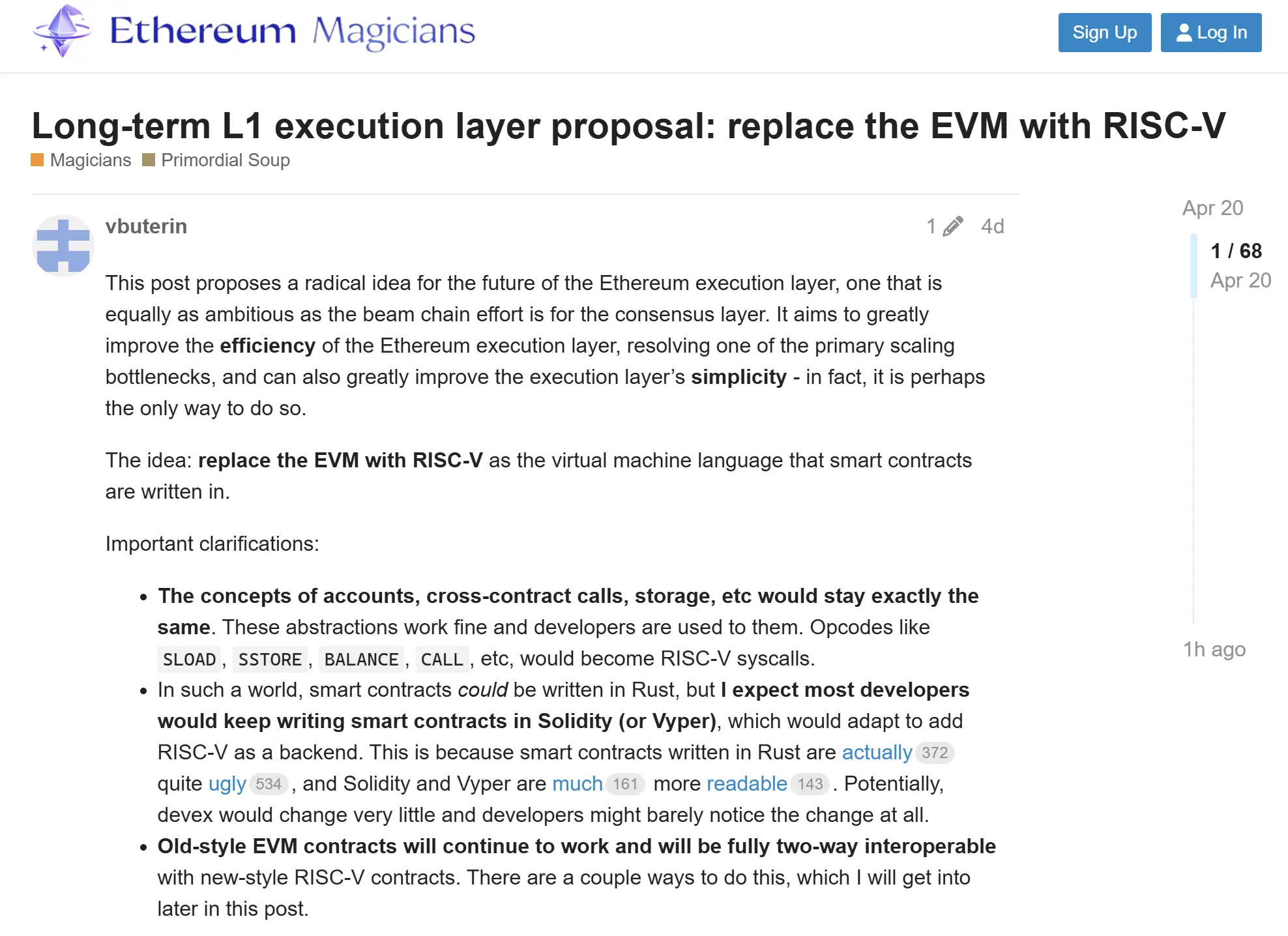
If this direction comes true, it will completely change the way Ethereum smart contracts operate and lay a technical foundation for its scalability in the next decades.Crypto KOL Daewoo pointed out that if the proposal is successful, the speed of the Ethereum main network can be increased by 100 times, and the transaction fee will be reduced by more than a thousand times. The value of Layer 2 may decline. Ethereum will directly challenge the high-speed public chains such as Solana and Sui, and superimpose the advantages of decentralization and ecological accumulation, and give it the wings of speed.
Although the proposal currently faces risks such as community opposition, its emergence has sent a strong signal: Ethereum is turning its attention to its mainnet value again. As commented by community user @shmula, Vitalik's proposal has historically left Ethereum Layer 1 "abandoned", but this proposal is expected to reinject value into it.
The "default choice" of traditional finance?
Traditional institutions also seem to prefer Ethereum. Bank of New York Mellon, one of the world's largest custodial banks, recently launched on-chain data tool Digital Asset Data Insights on Ethereum, and BlackRock's tokenized fund BUIDL has also deployed more than $2.3 billion on Ethereum.
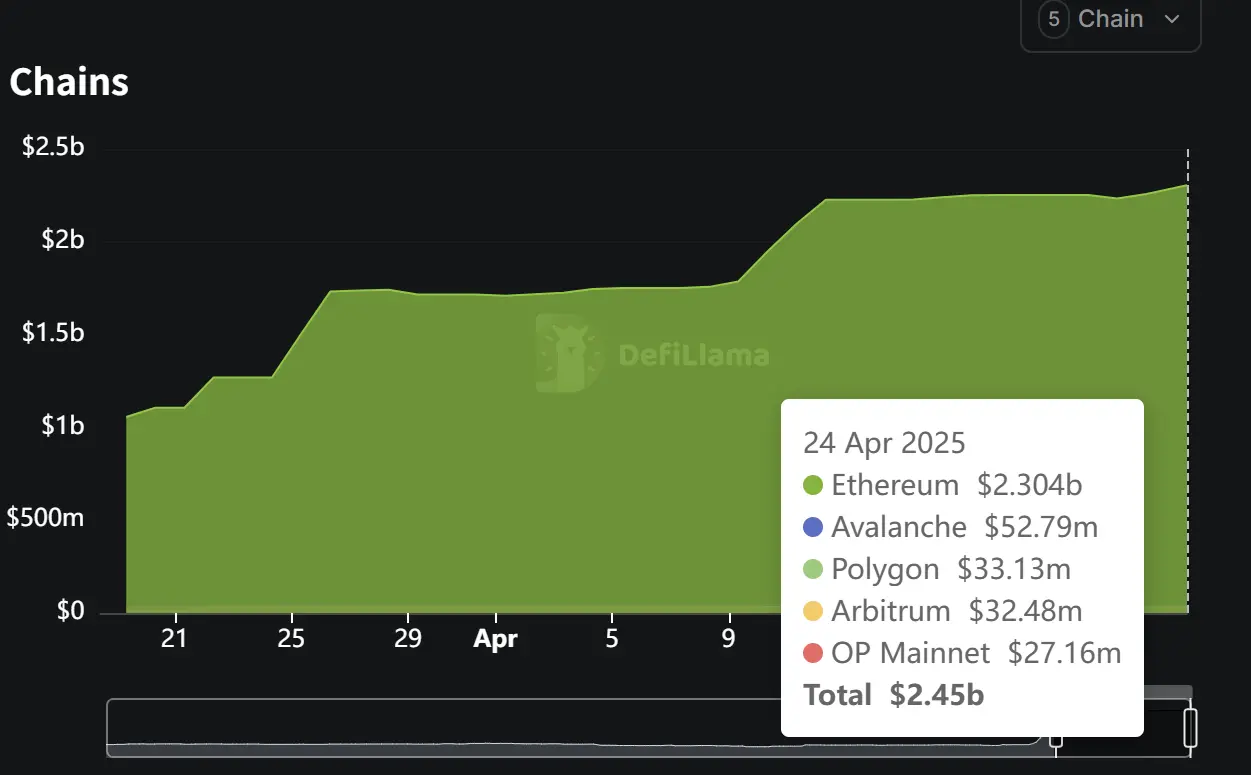
Data: Defilama, BUIDL funds distribution in each chain
Does all this mean that traditional institutions are actively contacting the Ethereum ecosystem and starting to experiment around its security, transparency and composability?Encryption KOL Blue Fox also proposed a forward-looking idea: Will large financial institutions build exclusive L2 or private chains on the Ethereum security layer in the future?
The views of LXDAO sponsor brucexu.eth may give us some inspiration. He said that some Hong Kong financial institutions and asset-opening projects that have been exposed to recently generally choose Ethereum as the underlying platform, because at the current stage, it is almost the only preferred solution. He pointed out: "From the perspective of functionality, Bitcoin lacks flexible scalability; from the perspective of stability and neutrality, financial institutions cannot accept public chains that may be intervened by states or face the risk of downtime; while emerging blockchains have not yet passed the test of time and security, and their maturity still needs to be verified."
These early moves may be just the prologue. But in the short term, whether Ethereum can realize value realization is very important, and the explosion of the application layer is very important.
Wanlian looks up to it, or is it a hero who is old?
From the Ethereum Foundation's replacement of its core team in February this year to the recent proposal to support RISC-V virtual machines, Ethereum is showing an "active correction". Tomasz K. Stańczak, executive director of the Ethereum Foundation, recently admitted that Ethereum’s “secondary goal” is to become the preferred infrastructure for institutions and win the market for real-world assets such as RWA and stablecoins.
All the trends are not pessimistic, and even the technical side is turning around. According to Trend Research's research and analysis, ETH is at a critical position in the sub-resistance swap, and if it breaks through, it may usher in a favorable trend reversal. ETH has experienced a long decline of 5 months since December 2024, and the number of profit addresses has dropped to a lower position in the bear market and has continued to be oversold. It is currently in a critical support range with the recovery of the crypto market.
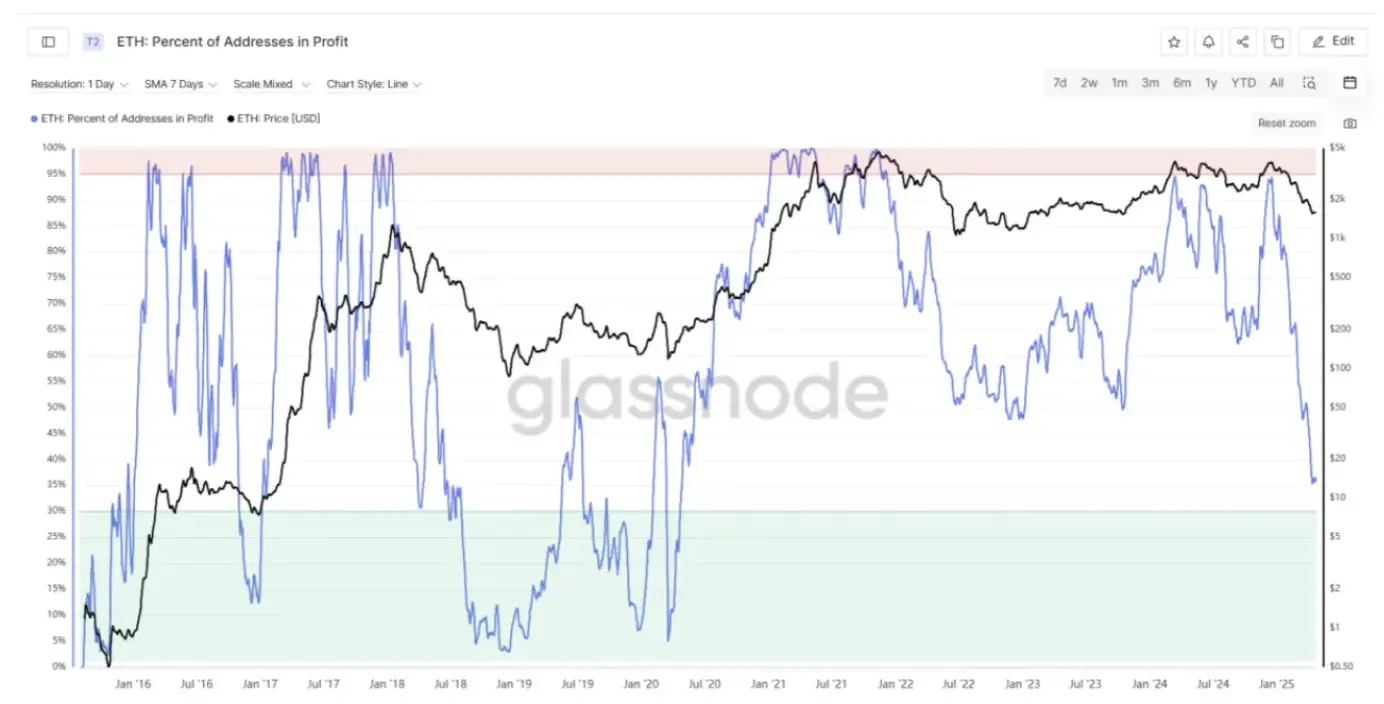
Profit address data
Trend Research pointed out that many technical indicators also emit potential bottoming signals. Multiple indicators such as ETH's K-line pattern, moving average, MACD and Momentum, RSI and MFI all point to the possibility of a long and short turning point in the short term. The current price is also approaching the upper edge and horizontal pressure levels of the downward channel, and is trying to break through.
Ethereum seems to be ushering in its "critical window period", but as the Chinese say, "Before you want to win, think about defeat first", even if the situation begins to shine, you can't help but ask: What will happen if you fail in the end? If these efforts are ultimately difficult to break through performance bottlenecks, ecological development has stagnated or fail to regain price confidence, will Ethereum become the "doomsday tank" of the new era?
Ten years are the node of time and the test of faith. The wheels of the times roll forward, and when success comes, thousands of chains look up to them, and when defeat comes, heroes are old.















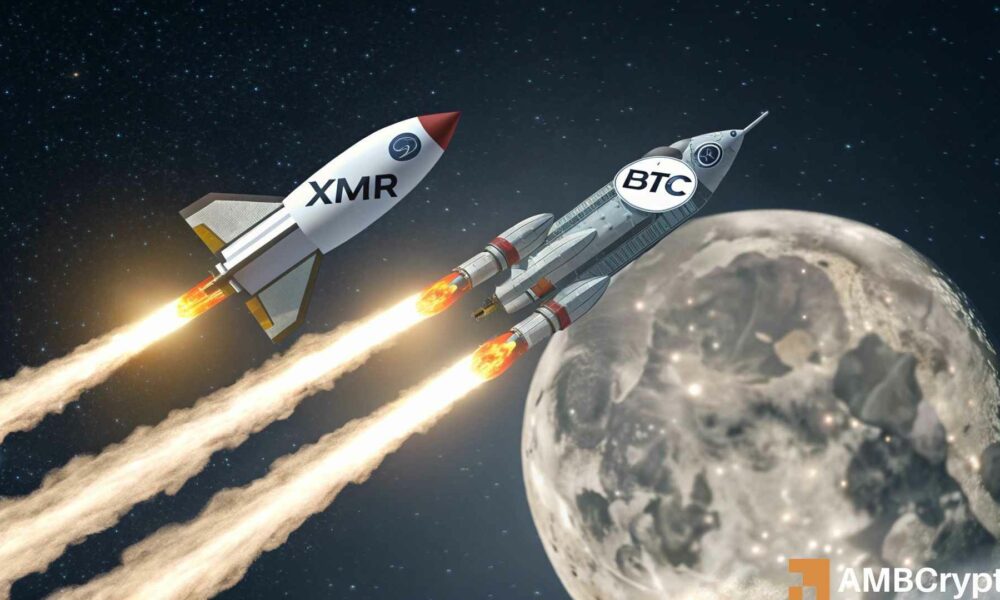
No comments yet